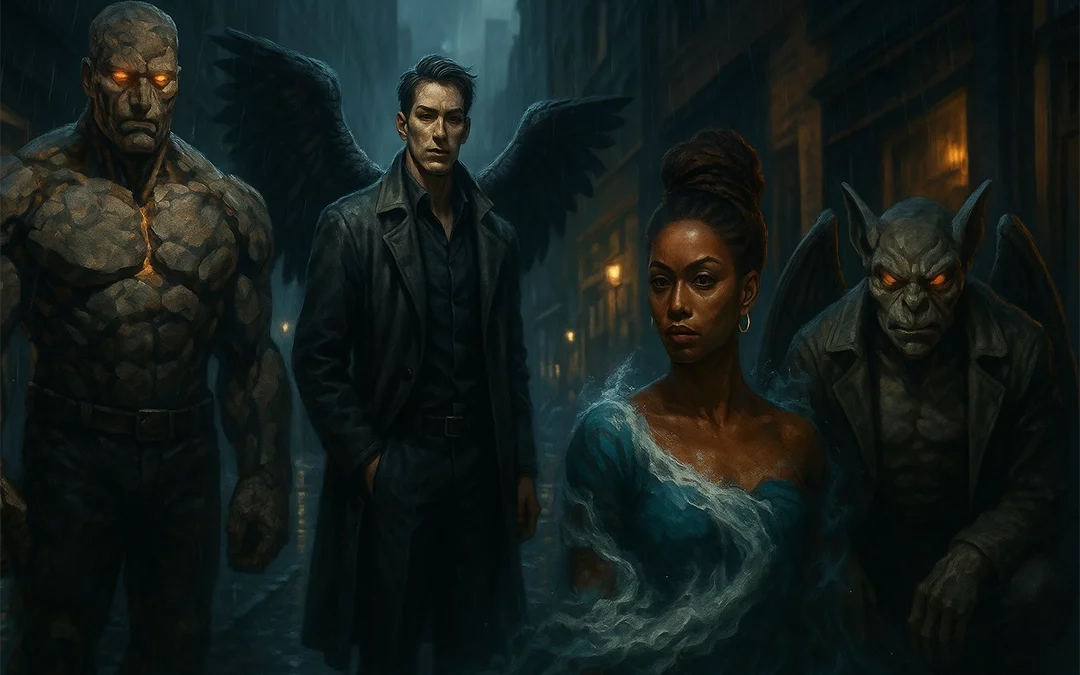Urban fantasy is known for blending magical elements with modern city life. While vampires and werewolves often headline the genre, many authors go beyond these familiar archetypes to introduce far more unusual creatures.
This exploration will highlight a curated selection of magical beings, from folkloric spirits to entirely original inventions, that populate urban fantasy novels in English.
We’ll look at what these creatures are, the books and authors that feature them, the roles they play in their stories, and why city settings make such inventive creature designs possible.
Let’s step into the bustling streets and shadowy alleys where the mythic meets the modern, and discover some extraordinary denizens of urban fantasy’s urban jungles.
The City: Where Myth Meets Modernity
Before diving into specific examples, it’s worth noting why urban fantasy is such fertile ground for inventive creatures.
Urban environments juxtapose skyscrapers and subways with age-old legends, creating a playground for imagination. In a city, a goblin can lurk beneath a manhole cover, or an ancient river goddess might preside over a modern metropolis.
Authors around the world have leveraged this backdrop to “merge the mythic and the modern,” letting legendary beings slip into crowded streets and interact with contemporary society.
The contrast between magical creatures and everyday urban life often carries metaphorical weight: these beings can symbolize the hidden histories of a city, the cultural melting pot of urban centers, or the unseen struggles of outsiders trying to blend in.
In short, urban fantasy’s cityscape is a canvas that encourages creative creature design, and readers have been rewarded with a whole menagerie beyond the expected vampires and werewolves.
Below, we’ll tour a selection of unusual creatures in urban fantasy, each accompanied by the book (and author) where they appear, a brief description, and a note on their role or thematic significance.
From folkloric golems and river spirits to entirely new creations like electric angels and religious mice, these examples demonstrate the genre’s endless capacity for wonder.
A Golem and a Jinni in 1899 Manhattan – The Golem and the Jinni (Helene Wecker)
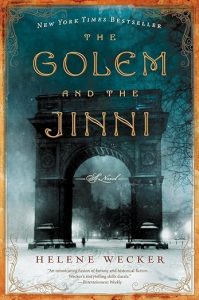 One standout example of non-traditional creatures in an urban fantasy setting is found in Helene Wecker’s The Golem and the Jinni (2013).
One standout example of non-traditional creatures in an urban fantasy setting is found in Helene Wecker’s The Golem and the Jinni (2013).
This historical urban fantasy introduces Chava, a golem – a being molded from clay and animated by Kabbalistic magic – and Ahmad, a jinni (genie) from Syrian folklore. Both creatures arrive as immigrants in 1899 New York City, bringing Jewish and Arab mythical heritage into the urban melting pot.
Chava was created to be a perfect wife but loses her master soon after arrival, leaving her an ownerless golem in an alien land. Ahmad, freed from a wizard’s flask in Manhattan’s Little Syria, is a fire spirit trapped in human form, struggling with newfound limitations.
In the novel, these two unusual beings form an unlikely friendship as they try to “insinuate themselves into the mundane world” of turn-of-the-century NYC.
The golem’s role is that of a protector with no one to protect – she grapples with her inherent need to obey and serve, versus forging her own identity. The jinni’s role is almost the opposite: a free-spirited entity now constrained, he chafes against societal rules. Both creatures become mirrors of the immigrant experience. They “struggle to survive and find meaning in their existences, and in doing so, bring changes to the humans around them”.
Thematically, their story is a poignant metaphor for outsiders adapting to a new city. By using a golem and a jinni instead of more familiar monsters, Wecker highlights cultural diversity in myth and makes the city itself feel enchantingly multicultural.
This novel demonstrates how urban fantasy can refresh folklore – two “immigrants of unusual stock” (a woman of clay from Poland and a djinn from the Syrian desert) finding a home in New York–-creating a magical mural of the immigrant experience within a bustling metropolis.
The Phouka: A Trickster Faerie Bodyguard – War for the Oaks (Emma Bull)
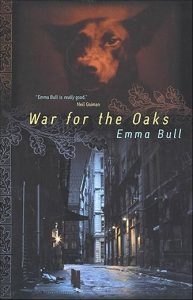 Going back to one of the classic pioneers of urban fantasy, Emma Bull’s War for the Oaks (1987) features a creature far removed from vampires and werewolves: a phouka.
Going back to one of the classic pioneers of urban fantasy, Emma Bull’s War for the Oaks (1987) features a creature far removed from vampires and werewolves: a phouka.
In Celtic folklore, a phouka (or púca) is a shapeshifting fey trickster, and in this Minneapolis-set novel, that’s exactly what Eddi McCandry encounters.
While walking home at night, Eddi is trailed by a mysterious man and a large black dog – who turn out to be “one and the same: a shapeshifting prankster faerie known as a phouka”. This phouka can shift between human form (an androgynously stylish young man, often compared to the musician Prince in appearance) and a dog form.
The role of the phouka in War for the Oaks is both protector and instigator. He essentially drafts Eddi into an ongoing supernatural war between the Seelie and Unseelie Courts of Faerie, with the fate of the city at stake. As a bodyguard, he sticks by Eddi’s side – sometimes infuriating her with mischievous antics, other times saving her life with his canine ferocity.
The novel is as much about forming a new rock band as it is about faerie battles, and the phouka embodies that blend of modern and mythic. He cracks jokes, quotes rock lyrics, and provides romantic tension, all while being a centuries-old fae creature under a glamour. Thematically, the phouka represents the collision of ordinary life with fairy tale chaos: he uproots Eddi’s mundane world, forcing her (a rock singer) to believe in magic.
By featuring a Celtic trickster-faerie rarely seen in urban settings, Emma Bull’s novel set the stage for urban fantasy’s love of inventive creatures. The phouka’s presence shows that even a midwestern city can harbor ancient magic, and that not all urban protectors need to be brooding vampires – some might be shaggy black dogs with a sense of humor.
The Great Beast of London: Urban Legend Come Alive – Neverwhere (Neil Gaiman)
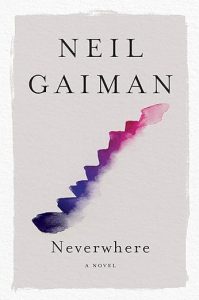 In Neil Gaiman’s Neverwhere (1997), the city of London itself becomes a character – especially the phantom “London Below” where forgotten people and things end up.
In Neil Gaiman’s Neverwhere (1997), the city of London itself becomes a character – especially the phantom “London Below” where forgotten people and things end up.
Amid the tunnels and sewers of this underground realm lurks an unforgettable creature: the Beast of London. This Beast is an enormous, legendary boar-like monster said to roam the labyrinth beneath the city.
According to the novel’s lore, it might have begun as a pig that escaped into the sewers ages ago and “grew larger and fouler as the years passed,” feeding on the filth below.
Over time, it became increasingly vicious, armored by the broken weapons of countless hunters who failed to kill it – their blades left bristling in its hide.
By the time protagonist Richard Mayhew encounters it, the Beast is less an animal and more an urban legend given flesh: a creature of “extreme strength,” scarred by centuries of combat, guarding the deepest passages of London Below.
The Beast’s role in Neverwhere is both literal and symbolic. Literally, it is the fearsome final obstacle that Richard must face – slaying the Beast is Richard’s heroic rite of passage, marking his transformation “from bumbling fool into the Warrior”.
The fight is brutal and otherworldly, taking place in dark caverns with a spear from Arthurian legend. Symbolically, the Beast represents the ancient, hidden dangers of a city: all those dark, forgotten nightmares that lurk beneath the sidewalks.
It’s the kind of creature that could only exist in an urban fantasy – born from the imagination of a metropolis that has accumulated countless myths. By going beyond vampires to use a creature like the Beast, Gaiman highlights the inventiveness of urban fantasy.
The Beast of London is unique to its city, a manifestation of London’s history and mystery. It shows how an author can take a city’s folklore (sewer alligators and monstrous boars) and elevate it to epic, mythic status.
In the end, the Great Beast is slain, but its legend cements London Below as a place where unusual creatures are as integral to the setting as the Tube stations and cobblestones.
Living Gargoyle Guardian – Heart of Stone (C.E. Murphy)
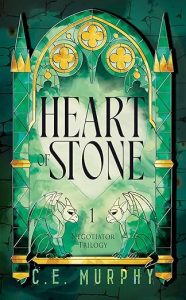 Gargoyles – those stone grotesques perched on old cathedrals and skyscrapers – are rarely the heroes of fantasy stories. But in C.E. Murphy’s Heart of Stone (2007), a gargoyle steps into the spotlight as a main character.
Gargoyles – those stone grotesques perched on old cathedrals and skyscrapers – are rarely the heroes of fantasy stories. But in C.E. Murphy’s Heart of Stone (2007), a gargoyle steps into the spotlight as a main character.
The novel is set in modern New York City, where lawyer Margrit Knight discovers that the mysterious man she’s been meeting in Central Park is actually Alban – a living gargoyle in human disguise. Alban is “a gargoyle, one of the five Old Races that still exist within the city limits”. (Those Old Races, in Murphy’s universe, include dragons, selkies, djinn, and vampires – but it’s the gargoyle who takes center stage in this story.)
Alban’s role is that of a wrongly accused guardian and unlikely ally. When a series of murders hits the city, Alban is framed as the prime suspect (after all, witnesses saw a tall, pale figure, and what could be paler than living stone?).
He turns to Margrit for help in proving his innocence. As Margrit delves deeper, she enters a hidden world of the Old Races, negotiating peace and uncovering conspiracies. Alban the gargoyle becomes both her client and her protector. By night, he shows her how he can shift from human form into a winged, stone-skinned gargoyle, patrolling the Manhattan skyline.
The imagery of a gargoyle perched on a skyscraper brings a deliciously literal flavor of urban fantasy – a medieval monster adapting to a modern city.
On a thematic level, the gargoyle represents steadfast protection and the idea that ancient beings can watch over contemporary humanity. Alban is centuries old; he’s seen New York grow from a colonial town to a metropolis. His perspective helps Margrit (and readers) consider the city’s history and the coexistence of old magic with new infrastructure. Importantly, Heart of Stone moves beyond the typical vampire/werewolf narrative by choosing a guardian gargoyle as the love interest and hero.
The novel plays with the notion of “What is human?” – Alban may look monstrous, but his honor and compassion make him more humane than many mortals. Murphy’s use of a gargoyle underscores how urban fantasy authors often rescue lesser-used mythic creatures from obscurity and give them new life among skyscrapers.
After reading this book, you might find yourself glancing up at New York’s gargoyles at night, wondering if one just moved…
River Spirits as Urban Gods – Rivers of London (Ben Aaronovitch)
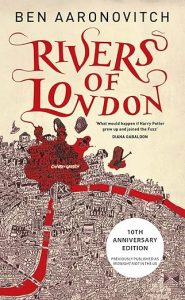 Ben Aaronovitch’s Rivers of London (2011), known in the US as Midnight Riot, opens with a memorable encounter that immediately signals this isn’t just another vampire story.
Ben Aaronovitch’s Rivers of London (2011), known in the US as Midnight Riot, opens with a memorable encounter that immediately signals this isn’t just another vampire story.
Police constable Peter Grant, newly aware of London’s magical underworld, gets embroiled in a feud between River Spirits – actual personifications of the River Thames and its tributaries. In this series, the major waterways of London have genius loci, or local gods. Mama Thames rules the tidal Thames through the city, appearing as a formidable Nigerian matriarch who can command the river’s waters. Upriver, Father Thames (an old man embodying the Thames’s source) governs the upper river.
These two have divided London’s river between them, and their children – personified tributary spirits like Beverley Brook, Fleet, Tyburn, etc. – are like a feuding family of minor deities. In the universe’s lore, “river spirits of large and influential rivers such as the Thames are treated like royalty by the magical community”. Indeed, Mama Thames and Father Thames each hold seasonal “courts” where other supernatural denizens must pay homage to them.
The role of these river spirits in Rivers of London is central to the plot and world-building. Peter Grant’s first big case involves mediating between Mother Thames and Father Thames to prevent an all-out magical turf war over who controls the river through the city. This is urban fantasy diplomacy at its finest – instead of rival vampire clans, we have hydrological gods at odds. Thematically, the river spirits highlight how urban fantasy can weave local culture and geography into creature design.
London, a city defined by the Thames, here literally has the Thames as a character with agency, grudges, and a family. It’s a clever twist on mythology: many cultures have river deities, but Aaronovitch brings them into 21st-century London with smartphones and police procedurals. The presence of a West African Mother Thames also underscores the global influence in urban fantasy – reflecting London’s multicultural makeup and giving a nod to the Yoruba river goddess Oshun as inspiration for the character.
Beyond their metaphorical significance (rivers as the lifeblood of a city, now given voices), the unusual creatures simply make the story fun and distinct. When you have a scene where the protagonist has tea with a river goddess in a housing estate, or gets romantically involved with Beverley Brook (the personified brook), you know the book is delightfully “beyond vampires and werewolves.” Rivers of London shows urban fantasy’s knack for turning city infrastructure into a pantheon of inventive creatures.
Blue Electric Angels: Urban Elementals of Modern Life – A Madness of Angels (Kate Griffin)
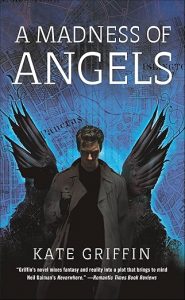 Sometimes, the creatures in urban fantasy aren’t drawn from any established folklore at all, but invented wholesale to embody the spirit of modern cities. One striking example comes from Kate Griffin’s A Madness of Angels (2009), the first of her Matthew Swift novels set in London. Here we meet the Blue Electric Angels – and they are unlike any angels you’ve heard of before. These entities are described as “more demonic than angelic in spirit,” a collective of electric-blue life that “have always lived in the telephone lines, formed from the words and emotions picked up from conversations” humming through the wires.
Sometimes, the creatures in urban fantasy aren’t drawn from any established folklore at all, but invented wholesale to embody the spirit of modern cities. One striking example comes from Kate Griffin’s A Madness of Angels (2009), the first of her Matthew Swift novels set in London. Here we meet the Blue Electric Angels – and they are unlike any angels you’ve heard of before. These entities are described as “more demonic than angelic in spirit,” a collective of electric-blue life that “have always lived in the telephone lines, formed from the words and emotions picked up from conversations” humming through the wires.
In Griffin’s imaginative cosmology, the very energy of urban communication coalesced into sentient magical beings. When the sorcerer protagonist Matthew Swift is murdered and then mysteriously resurrected, he finds that he is not alone in his own body – the Blue Electric Angels from the city’s electrical grid have merged with him. Matthew comes back as a fusion of man and these crackling entities: “Matthew and the angels are now fused into one sentient being,” sharing his memories and their otherworldly motivations.
The role of the Blue Electric Angels is multifaceted. They essentially are the protagonist (or part of him), giving Matthew extraordinary powers drawn from the city’s electrical network – he can speak with the voice of countless telephones and unleash devastating lightning-like magic. They also provide a constant eerie commentary in his mind, at times childlike and naive, at others alien and wrathful.
Thematically, these creatures represent the modern “soul” of the city – they are born from human communication, literally the city’s collective chatter turned into a ghostly life form. This makes a profound statement: in a world of telephone cables and power lines, even our technology and infrastructure might spawn new kinds of mythic beings. It’s urban fantasy pushing into the 21st-century: no ancient scrolls or traditional monsters here, but something entirely new that could only emerge in a metropolis.
The Blue Electric Angels also serve as a metaphor for connectivity and isolation in urban life – they are made of voices and feelings from phone calls, suggesting that even the most impersonal modern systems carry human emotion that can spark magic. By creating the Blue Electric Angels, Kate Griffin goes far beyond vampires and werewolves, showing that urban magic can be as original as a city is complex.
Readers often get chills at the first line of the book, when Matthew/Angels awakens saying, “We dreamed of electric angels.” This creature is a reminder that urban fantasy can invent its own mythology, one that feels completely at home amid neon lights and ringing telephones.
The Aeslin Mice: Tiny, Holy & Hilarious – InCryptid series (Seanan McGuire)
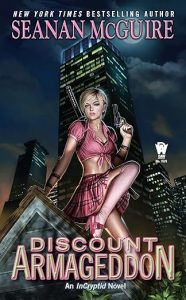 Not all unusual creatures in urban fantasy are fearsome or godlike – some are adorably bizarre. Case in point: the Aeslin Mice from Seanan McGuire’s InCryptid series (starting with Discount Armageddon, 2012).
Not all unusual creatures in urban fantasy are fearsome or godlike – some are adorably bizarre. Case in point: the Aeslin Mice from Seanan McGuire’s InCryptid series (starting with Discount Armageddon, 2012).
These aren’t your garden-variety mice; they are a species of intelligent, talking rodents with a penchant for religious zeal. In fact, the Aeslin mice have formed a fanatical little cult that worships the human family (the Price/Healy family) who shelters them.
As one description puts it: “The Aeslin mice of Seanan McGuire’s ‘InCryptid’ novels… have human-level intelligence, and worship the narrating family as gods & goddesses. Aeslin [mice] observe all aspects of their deities’ lives (unless bribed with food), have the ability to turn any moment into Holy Scripture, and can repeat whole conversations… at the drop of a hat.”
In other words, imagine a household of tiny, hyper-enthusiastic mice in ceremonial garb, constantly holding festivals and shouting hallelujahs for events like “THE COMING OF THE GOD OF LEFTOVERS (when you raid the fridge)” or “HALLOWED BE THE WEDDING OF THE PRINCESS” when a family member gets married.
The Aeslin mice appear throughout the series, often as sidekicks and comic relief, but they also have an important role in the lore. They carry the family’s history (with perfect recall and oral tradition of everything that happens). They’ll cheerfully help in fights (a swarm of devout mice can in fact take down larger predators when needed), and their incessant celebrating can lighten the darkest moments.
Thematically, these unusual creatures underscore one of Seanan McGuire’s themes: coexistence and community in a world of monsters. The Price family are cryptozoologists who protect supernatural creatures, and in return they’ve gained literal worshippers in these mice. It’s a quirky symbiosis that flips the usual human-monster dynamic on its head – here the humans are revered as near-divine, and the “monsters” are cute, pious little rodents. The Aeslin mice also serve as a metaphor for the weight of family legacy (they never forget any detail, which is both endearing and burdensome when you’d rather some youthful embarrassments be forgotten).
Most importantly, they bring joy and uniqueness to the series. In a genre that can sometimes lean on brooding, dark creatures, the Aeslin mice prove that unusual creatures can be lighthearted and still enrich the world-building. After meeting them, you’ll never look at the mice in your attic the same way – perhaps they’re busy composing sacred hymns about your daily routines! McGuire’s inclusion of the Aeslin mice is a brilliant example of urban fantasy’s imaginative range, extending beyond the expected creatures to include the downright whimsical.
The Naagloshii: An Ancient Shapeshifter of Dread – The Dresden Files (Jim Butcher)
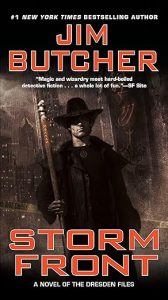 Jim Butcher’s The Dresden Files (2000–present) is famous for mixing a wide variety of mythologies into its modern Chicago setting – everything from vampires and faeries to demons, ghosts, and beyond. One particularly terrifying creature that goes far beyond the usual suspects is the Naagloshii, also known as a skinwalker, introduced in Turn Coat (2009). Drawn from Navajo legend, a Naagloshii is “an immortal semidivine being with the ability to change shape”.
Jim Butcher’s The Dresden Files (2000–present) is famous for mixing a wide variety of mythologies into its modern Chicago setting – everything from vampires and faeries to demons, ghosts, and beyond. One particularly terrifying creature that goes far beyond the usual suspects is the Naagloshii, also known as a skinwalker, introduced in Turn Coat (2009). Drawn from Navajo legend, a Naagloshii is “an immortal semidivine being with the ability to change shape”.
Unlike benign shapeshifters, this creature is profoundly malevolent – it can assume any animal’s form but with a monstrous twist, and it wields powerful sorcery of its own. In Butcher’s novel, the Naagloshii arrives as an almost unstoppable assassin hunting down wizards. It’s described as thriving on fear: “The more afraid you are, the more powerful they become,” Harry Dresden notes, as the Skinwalker literally gains strength by feeding on its prey’s terror.
With a horrific psychic presence that can paralyze even a seasoned wizard, the Naagloshii stands out as one of the most lethal foes in the entire Dresden saga.
The role of this creature in Turn Coat is that of a near-mythic antagonist. Harry Dresden, a modern wizard-detective, finds himself woefully outmatched when facing it – the Skinwalker embodies the ancient darkness encroaching on the urban. It takes all of Harry’s allies and ingenuity to even slow it down.
Thematically, the Naagloshii brings an element of Native American folklore into an urban setting, exemplifying how the genre can pay homage to global and indigenous mythologies rather than recycling European monsters alone. Its presence also raises the stakes: readers realize there are things older and scarier than vampires stalking the streets.
By including a creature like the Naagloshii, Butcher expands his world’s scope and demonstrates the rich diversity of monsters available to urban fantasy. This Skinwalker is not just a random beast; it’s a messenger of the Navajo Holy People gone rogue, carrying with it a sense of cultural weight and primal horror.
When it rampages through modern-day Chicago, it turns the city into a hunting ground reminiscent of ancient legends. In sum, the Naagloshii shows that urban fantasy can tap into any folklore – no matter how rarely seen in pop culture – and make it at home in a contemporary narrative. It’s a reminder that beyond the werewolves (who do appear in Dresden Files, but pale in comparison), there are far stranger and older things that go bump in the night.
The Endless Menagerie of Urban Fantasy
From golems forging new identities in New York, to trickster fae rocking out in Minneapolis, to river gods holding court by the Thames, we’ve seen that urban fantasy is a genre with astonishing creature diversity. These unusual beings are not included just for shock value – each one enhances the story’s connection between the magical and the mundane. Urban fantasy authors use such creatures to illuminate themes of cultural blending, the soul of a city, the humor in community, or the terror of the unknown lurking in an alley. Crucially, placing these entities in urban settings lets writers play with contrast: the ancient against the ultra-modern, the legendary against the everyday.
Why does the urban environment lend itself so well to inventive creature design? Perhaps because cities themselves are inherently magical – they’re crossroads of humanity, repositories of history, and hotbeds of innovation. In a single city block, you might find a 200-year-old building next to a tech startup, people from dozens of ethnic backgrounds, stories layered upon stories.
Urban fantasy simply takes that richness and asks, “What if that old building had a gargoyle watching from it? What if an electric current could dream? What if the city’s river was literally alive?”
The answers give us creatures that feel both surprising and fitting. A metropolis can hide a monster in plain sight far more easily than a small village, after all, and it offers endless nooks for the supernatural to nestle into our reality.
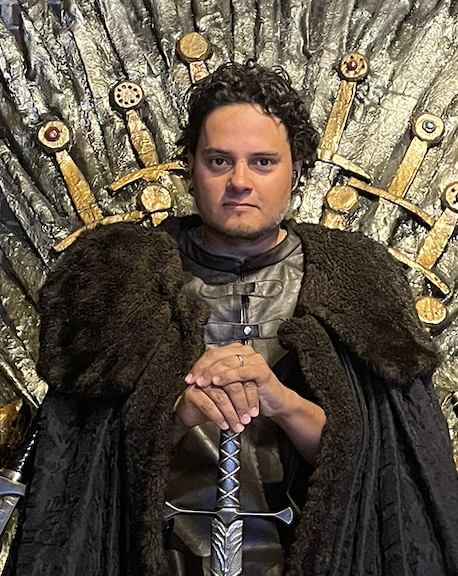
D.P. Martinez is a contemporary fantasy author specialising in urban fantasy and magical realism. He holds an M.A. in English Literature from the University of Greenwich, where he focused on Literary London. His research explored metaphorical representations of London in urban fantasy. He has written hundreds of articles and several books across both fiction and non-fiction.

